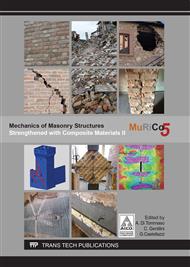[1]
J. Bérchez. Valencia. Arquitectura Religiosa. Tomo X. Consellería de Cultura, Educación y Ciencia. (1995).
Google Scholar
[2]
M.A. Orellana. Valencia Antigua y Moderna. Tomos I, II y III. Editorial Acción Bibliográfica Valenciana. Valencia. (1924).
Google Scholar
[3]
J. Moreno Puchalt, A. Alonso Durá, A. Martínez Boquera, V. Llopis Pulido. Structural behavior analysis of the bell tower of Santa Catalina's Church of Valencia. Proceedings of the 9th International Conference on Structural Analysis of Historical Constructions. SAHC 2014, pp.1-12. (2014).
Google Scholar
[4]
M. Cassinello. Trazado y estabilidad de la arquitectura gótica. Cuadernos Intemac. 53. (2004).
Google Scholar
[5]
P. Cassinello. Influencia de los Terremotos Históricos en la Construcción de las Catedrales Góticas Españolas. Annali Di Architettura: Rivista del centro Internazionale di Studi di Architettura Andrea Palladio,. 17: 9-20. (2005).
DOI: 10.3989/ic.86023
Google Scholar
[6]
A. Alonso Durá, A. Martínez Boquera, V. Llopis Pulido, J. Moreno Puchalt. Structural Behaviour Analysis of the Cathedral of Valencia. Structural Analysis of Historical Constructions, SAHC. Wroclaw, Poland. (2012).
Google Scholar
[7]
V. Llopis Pulido, A. Alonso Durá, E. Fenollosa, A. Martínez Boquera. Análisis constructivo y estructural de la catedral de Valencia. Informes de la Construcción, 68(543): e158, doi: http: /dx. doi. org/10. 3989/ic. 15. 102. (2016).
DOI: 10.3989/ic.15.102
Google Scholar
[8]
J.M. Canet, Barbat, A. H. B. Estructuras sometidas a acciones sísmicas: Cálculo por ordenador. (1988).
Google Scholar
[9]
P. B Lourenço. Experimental and numerical issues in the modelling of the mechanical behaviour of masonry. In Structural Analysis of Historical Constructions II. Publ., Barcelona. (1998).
Google Scholar
[10]
E. Oñate, A. Hanganu, A. Barbat. Structural Analysis and Durability Assessment of Historical Constructions using a Finite Damage Model. Cimne, Barcelona. (1996).
Google Scholar
[11]
M. Valcuende, J. Benlloch. Ductility of reinforced concreted beams strengthened with CFRP strips and fabric. FRPRCS-6: Externally bounded Reinfocement for fleixure.
DOI: 10.1142/9789812704863_0030
Google Scholar
[12]
A. Alonso Durá. ANGLE: Software of structural analysis by finite elements developed in the Departamento de Medios Continuos y Teoría de Estructuras at Escuela Técnica Superior de Arquitectura de Valencia.
Google Scholar
[13]
A. Alonso Durá. Un modelo de integración del análisis estructural en entornos de CAD, para estructuras de edificación, Tesis doctoral. Valencia. (2003).
Google Scholar
[14]
S. Oller. Fractura mecánica. Un enfoque global. Cimne. Barcelona. (2001).
Google Scholar
[15]
Eurocode 8: Design of structures for earthquake resistance. Part1: General rules, seismic actions and rules for buildings. (2004).
DOI: 10.3403/03244372u
Google Scholar
[16]
NCSE-02. Norma de Construcción Sismorresistente: Parte general y edificación. Ministerio de Fomento (Spanish Standard).
Google Scholar
[17]
S. Ivorra, F. J. Pallarés, M.L. Romero. Numerical and Experimental Study of the Dynamic Behaviour of San Nicolás Belltower. In Structural Analysis of Historical Constructions. New Delhi. (2006).
Google Scholar


